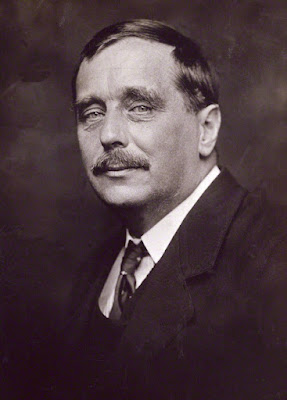Copyright 2018 by Gary L. Pullman
H. G. Wells's masterful
short story, “The Cone,” tells a simple, straightforward tale of
vengeance and horror. During his stay with Horrocks, who manages the
Jeddah Company Blast Furnaces, the artist Raut, who is making a study
of the ironworks, has an affair with Horrocks's wife, talk of which
the manager overhears, including his wife's confession of her love
for Raut.
During the lovers'
conversation, Horrocks's wife insults and denigrates her husband as
unimaginative and insensitive and praises Raut for the love and
beauty he has brought into her dull, drab life. Like Raut, she has an
aesthetic appreciation of life, whereas, she tells Raut, her husband
“thinks of nothing but the works and the prices of fuel,” having
“no imagination, no poetry.” Horrocks also overhears his wife's
mockery of him, before he enters the room and offers to take Raut for
a tour of the ironworks so the artist can get a better view of its
aesthetic effects.
As the men tour the
ironworks, Horrocks points out its “effects,” as he leads the
artist along, gripping his arm so firmly that it hurts Raut. On
their way through the industrial landscape, Horrocks explains how
cones have been added to block the throats of the furnaces so fire
doesn't “flare out” of them like “pillars of cloud by day . . .
and pillars of fire by night.” Despite the cones, however,
occasionally a furnace does belch “a burst of fire and smoke.”
A sign warns, “Beware
of the Trains.” As a train
approaches, Horrocks shoves Raut into its path, pulling him back at
the last moment, so that the artist narrowly escapes death. As they
resume the tour, Raut wonders whether Horrocks is aware of his affair
with his wife and whether, as a result, he had “just been within an
ace of being murdered.”
Continuing
the tour, Horrocks points out additional effects, such as the canal.
“You've never seen it? Fancy that! You've spent too many of your
evenings philandering,” Horrocks tells Raut.
They
take an elevator to a “narrow rail” overhanging a furnace seventy
feet below. “That's the cone I've been telling you of,” shouts
Horrocks, “and, below that, sixty feet of molten metal, with the air
of the blast frothing through it like gas in soda-water.” He adds
that the cone's “top side” is 300 degrees, which is hot enough to
“boil the blood out of you in no time.” Raut tries to escape,
struggling with Horrocks, who detains him, and Raut plunges into
“empty air.” Although his lower body makes contact with the “hot
cone,” Raut manages to cling to the chain from which the furnace's
cone is suspended, the tremendous heat singeing his hands and causing
“intense pain” to assail “him at the knees.” Raut tries to
ascend the chain, but Horrocks flings coal at him, shouting, “Fizzle
you fool! Fizzle, you hunter of women! You hot-blooded hound! Boil!
boil! boil!”
Only
after Raut, still clinging to the chain, has been immolated does
Horrocks's anger pass and “a deadly sickness [comes] upon him.”
as he smells “the heavy odour of burning flesh . . . . his sanity”
returning.
From
“below was the sound of voices and running steps. The clangour of
rolling in the shed ceased abruptly.”
*
* *
The
plot of Wells's story is itself a thing of beauty. Tight, unified,
and artistically executed, with every detail leading to the final
effect, it's a tale of terror worthy of Edgar Allan Poe.
Beyond
the plot itself, Wells's story is a masterpiece of literary
excellence because of its style. A tale of vengeance against an
artist, the story is rendered as if Raut himself might have painted
it, as a series of images, some impressionistic, others surreal.
Wells's protagonist doesn't only speak of the aesthetic effects of
his workplace, but the omniscient narrator's artistic descriptions of
these effects is like detailed verbal paintings, as these few samples
indicate:
The
night was hot and overcast, the sky red, rimmed with the lingering
sunset of mid-summer. . . . The trees and shrubs of the garden stood
stiff and dark; beyond in the roadway a gas-lamp burnt, bright orange
against the hazy blue of the evening. Farther were the three lights
of the railway signal against the lowering sky.
*
* *
Horrocks
pointed to the canal close before them now: a weird-looking place it
seemed, in the blood-red reflections of the furnaces. The hot water
that cooled the tuyeres
[“a nozzle through which air is forced into a smelter, furnace, or
forge”] came into it, some fifty yards up—a tumultuous, almost
boiling affluent, and the steam rose up from the water in silent
white wisps and streaks, wrapping damply about them, an incessant
succession of ghosts coming up from the black and red eddies, a white
uprising that made the head swim.
*
* *
They
went . . . through the rolling-mills
[“a factory or machine for rolling steel or other metal into
sheets”], where amidst an incessant din the deliberate steam-hammer
beat the juice out of the succulent iron, and black, half-naked
Titans rushed the plastic bars, like hot sealing-wax, between the
wheels. . . . They went and peeped through the little glass hole
behind the tuyeres, and saw the tumbled fire writhing in the pit of
the blast-furnace. It left the eye blinded for a while. Then, with
green and blue patches dancing across the dark, they went to the lift . . . .
These
descriptions support Horrocks's view of the ironworks as itself an
artistic setting as well as a technological marvel. Unlike Raut and
his own wife, Horrocks is able to see the beauty of technology and
industry. It is ironic that such beauty, as Horrocks perceives it and
the narrator describes it, should be the background to the artist's
demise at the hands of Horrocks and the technology of the ironworks
itself.
But
Wells achieves yet more through the figures of speeches, allusions,
and point of view his omniscient narrator employs in describing what,
to Horrocks, is a work of art and what is to his victim, “Gehenna,”
“a place of burning, torment, or misery.” From Horrocks's point
of view, the ironworks is described as a work of art; the furnace is
personified as Horrocks's “pet” (“I packed him myself, and he's
boiled away cheerfully with iron in his guts for five long years. I
have a particular fancy for him”);
and the water of the steaming canal is described with an allusion to
“sin” and “death,” just as the “flames” that once erupted
from the “throats” of the furnaces looked like God, as He
revealed Himself to Moses and the Israelites, as “pillars of cloud by day . . . and
pillars of fire by night” (Exodus 13:21-22) as they journeyed
through the wilderness.
Wells's
descriptions are dynamic, not static; they move and act, as if the
ironworks is itself a conscious entity, a willing instrument of its
manager's revenge. The movement prevents the plot from slowing, keeps
up the pace of the action, and is perfectly suited to the tour of
his workplace that Horrocks conducts. The descriptions heighten and
underscore the unity between Horrocks and his beloved ironworks,
emphasizing the relationship that exists between him, as a man, and
the industry and technology of the works he manages.
Horrocks's
appreciation of the beauty of the ironworks also suggests that both
the artist Raut and Horrocks's wife underestimate his sensitivity,
intelligence, and imagination. It is not that he lacks the ability to
appreciate beauty, but that the type of beauty he appreciates differs
from that of Raut and Horrocks's wife. They are detached from the
material world, thinking in terms of “effects” and of romantic
passion; a man of the earth, a “Titan,” Horrocks is immersed in
the physical world of labor and sweat, of industry and technology. To
him, the ironworks is a place of beauty, whereas, to Raut, it is a
“Gehenna,” a blot upon the beauty of the countryside, and, to
Horrocks's wife, it is a stifling, suffocating place devoid of beauty
and love. The story suggests that it is the illicit lovers who are
unable to appreciate beauty—at least the beauty that Horrocks is
able to see.
The
characters live in different worlds, which results in a conflict of
aesthetics, passion, and love that ends in horrible death for Raut, a
realization of the darkness within him for Horrocks, and the end of
an affair that Horrocks's wife said opened “a world of love” to
her. The story suggests that life, like the setting in which it is
experienced, may be a place of beauty which suggests the presence of
God, as the ironworks does for Horrocks, or a “Gehenna” of
torment and anguish suggestive of hell for those who cannot fathom
the beauty and majesty of the place. The story also suggests the
significance and power of aesthetics, for it is both the appreciation
of the ironworks's beauty, on Horrocks's part, and the failure to
appreciate the beauty of such a place, on Raut's and Horrocks's
wife's part, that leads to adultery, betrayal, vengeance, and murder
and to the horrific death of the artist at the hand of the
ironmaster:
His
human likeness departed from him. When the momentary red had passed,
Horrocks saw a charred, blackened figure, its head streaked with
blood, still clutching and fumbling with the chain, and writhing in
agony—a cindery animal, an inhuman, monstrous creature that began a
sobbing intermittent shriek.
Abruptly,
at the sight, the ironmaster's anger passed. A deadly sickness came
upon him. The heavy odour of flesh came drifting up to his nostrils.
His sanity returned to him.
“God
have mercy upon me!” he cried. “O God! what have I done?”
He
knew the thing below him, save that it moved and felt, was already a
dead man—that the blood of the poor wretch must be boiling in his
veins. An intense realisation of that agony came to his mind, and
overcame every other feeling. For a moment he stood irresolute, and
then, turning to the truck, he hastily tilted its contents upon the
struggling thing that had once been a man. The mass fell with a thud,
and went radiating over the cone. With the thud the shriek ended, and
a boiling confusion of smoke, dust, and flame came rushing up towards
him. As it passed, he saw the cone clear again.








































